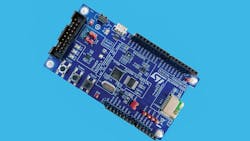BlueNRG-2 Development Kit Unleashes Bluetooth 5.0
The STEVAL-IDB008V1M Bluetooth Low Energy 5.0 (BLE) evaluation platform from STMicroelectronics accelerates application development with modules featuring BlueNRG-2, the company’s second-generation BLE System-on-Chip (SoC).
BlueNRG-2 supports the Bluetooth 5.0 certification, which allows enhanced security with LE Secure Connections, power-efficient privacy with Link Layer Privacy 1.2, and up to 2.6 times higher throughput with LE Data Length Extension. The SoC contains an Arm Cortex-M0 core operating at up to 32 MHz to handle the Bluetooth stack and application processing, and integrates new features including a 32-kHz ring oscillator, 24 KB of RAM and 256 KB of flash program memory. Reduced standby power is a further advantage, drawing just 0.9 µA in sleep mode with active Bluetooth stack and full RAM retention.
The BlueNRG-M2SA module combines in a compact 13.5-mm x 11.5-mm form factor the BlueNRG-2 SoC with an efficient ceramic antenna, RF balun circuit, and 32-kHz crystal oscillator and SMPS inductor to further reduce power consumption. Using this module greatly reduces engineering costs and enables designers to create wireless devices with minimal RF engineering expertise. BlueNRG-M2SA is qualified as a Bluetooth End Product, which relieves customers of additional testing to complete their own product qualification. The modules are also pre-certified according to US FCC, Canadian IC, European RED, Japan TYPE radio-equipment regulations and will also meet China SRCC requirements when those are finalized.
The STEVAL-IDB008V1M plug-and-play kit enables rapid evaluation and product development leveraging the BlueNRG-M2SA module. The board combines the BlueNRG-M2 module with sensors including a MEMS pressure and temperature sensor and motion sensors suitable for 9-axis sensor-fusion library. There is also a low-latency, low-power ADPCM codec, ready to use with BlueVoice middleware for voice-over-BLE streaming. Arduino R3 connectors are provided, which allow access to all the module’s peripherals and enable users to further extend functionality by adding expansion shields. The associated development-software package, STSW-BLUENRG1-DK, contains a simple and intuitive BlueNRG-Navigator GUI that lets users bring their applications to life without an external programmer or hardware.
The kit also simplifies integration of the BlueNRG-M2SA module with ST’s STSW-BNRG-MESH software to explore emerging application opportunities in industrial and smart-building markets. The software implements the Bluetooth SIG Mesh Profile v1.0 to allow true two-way communication and range-extending mesh networks, with cyber-security leveraging integrated features of the BlueNRG-2 SoC.
With its operating temperature range of -40°C to 85°C and 5-dBm RF output power, the BlueNRG-M2SA module can be powered directly with a pair of AAA batteries or any power source from 1.7 to 3.6 V. The module is well-suited for industrial applications.
The STEVAL-IDB008V1M evaluation kit is available now.
STMicroelectronics, www.st.com
